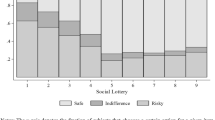Abstract
In this paper we examine how risk attitudes change with age. We present participants from age 5 to 64 with choices between simple gambles and the expected value of the gambles. The gambles are over both gains and losses, and vary in the probability of the non-zero payoff. Surprisingly, we find that many participants are risk seeking when faced with high-probability prospects over gains and risk averse when faced with small-probability prospects. Over losses we find the exact opposite. Children's choices are consistent with the underweighting of low-probability events and the overweighting of high-probability ones. This tendency diminishes with age, and on average adults appear to use the objective probability when evaluating risky prospects.
Similar content being viewed by others
References
Battalio, R.C., Kagel, J.H., and MacDonald, D.N. (1985). “Animals' Choices Over Uncertain Outcomes: Some Initial Experimental Results.” The American Economic Review. 75, 597–613.
Camerer, C. (1989). “An Experimental Test of Several Generalized Utility Theories.” Journal of Risk and Uncertainty. 2, 61–104.
Camerer, C. (1998). “Bounded Rationality in Individual Decision Making.” Experimental Economics. 1, 163–183.
Camerer, C. and Teck-Hua Ho. (1994). “Violations of the Betweenness Axiom and Nonlinearity in Probability.” Journal of Risk and Uncertainty. 8, 167–196.
Camerer, C. and Howard, K. (1989). “Decision Processes for Low Probability Events.” Policy Implications. 8(4), 565–592.
Eckel, D., Grossmann, P., Lutz, N., and Padmanabhan, V. (1998). “Playing it Safe: Gender Differences in Risk Aversion.” Unpublished manuscript.
Edwards, W. (1955). “The Prediction of Decisions Among Bets.” Journal of Experimental Psychology. 50, 201–214.
Holt, C.A. (1986). “Preference Reversals and the Independence Axiom.” The American Economic Review. 76, 508–515.
Isaac, R.M. and Duncan J. (2000). “Just Who Are You Calling Risk Averse?” Journal of Risk and Uncertainty. 20, 177–187.
Jianakopolos, N.A. and Bernasek, A. (1998). “Are Women More Risk Averse?” Economic Inquiry. XXXVI, 620–630.
Kagel, J.H., MacDonald, D.N., and Battalio, R.C. (1990). “Tests of “Fanning Out” of Indifference Curves: Results from Animal and Human Experiments.” The American Economic Review. 80(4), 912–921.
Machina, M.J. (1987). “Choice Under Uncertainty: Problems Solved and Unsolved.” Journal of Economic Perspectives. 1, 121–154.
Prelec, D. (1998). “The Probability Weighting Function.” Econometrica. 66, 497–527.
Quiggin, J. (1982). “A Theory of Anticipated Utility.” Journal of Economic Behavior and Organization. 3(4), 323–343
Ramsey, F.P. (1931). The Foundation of Mathematics. New York: Harcourt Brace.
Reyna, V.F. and Brainerd, C.J. (1995). “Fuzzy-Trace Theory: An Interim Synthesis.” Learning and Individual Differences. 7, 1–75.
Savage, L.J. (1954). The Foundations of Statistics. New York: Wiley.
Schlottmann, A. (2001). “Children's Probability Intuitions: Understanding the Expected Value of Complex Gambles.” Child Development. 72, 103–122.
Schlottmann, A. and Anderson, N.H. (1994). “Children's Judgments of Expected Value.” Development Psychology. 30, 56–66.
Schoemaker, P.J. (1982). “The Expected Utility Model: It'sVariants, Purposes, Evidence and Limitations.” Journal of Economic Literature. 30, 529–563.
Starmer, C. (2000). “Developments in Non-Expected Utility Theory: The Hunt for a Descriptive Theory of Choice Under Risk.” Journal of Economic Literature. 38, 332–382.
Tversky, A. and Fox, C.R. (1995). “Weighing Risk and Uncertainty.” Psychological Review. 102, 269–283.
Tversky, A. and Kahneman, D. (1992). “Advances in Prospect Theory: Cumulative Representation of Uncertainty.” Journal of Risk and Uncertainty. 5, 297–323.
Tversky, A., Slovic, P., and Kahneman, D. (1990). “The Causes of Preference Reversal.” The American Economic Review. 80, 204–217.
Wu, G. and Gonzalez, R. (1998). “Common Consequence Conditions in Decision Making Under Risk.” Journal of Risk and Uncertainty. 16, 115–139.
Author information
Authors and Affiliations
Rights and permissions
About this article
Cite this article
Harbaugh, W.T., Krause, K. & Vesterlund, L. Risk Attitudes of Children and Adults: Choices Over Small and Large Probability Gains and Losses. Experimental Economics 5, 53–84 (2002). https://doi.org/10.1023/A:1016316725855
Issue Date:
DOI: https://doi.org/10.1023/A:1016316725855




